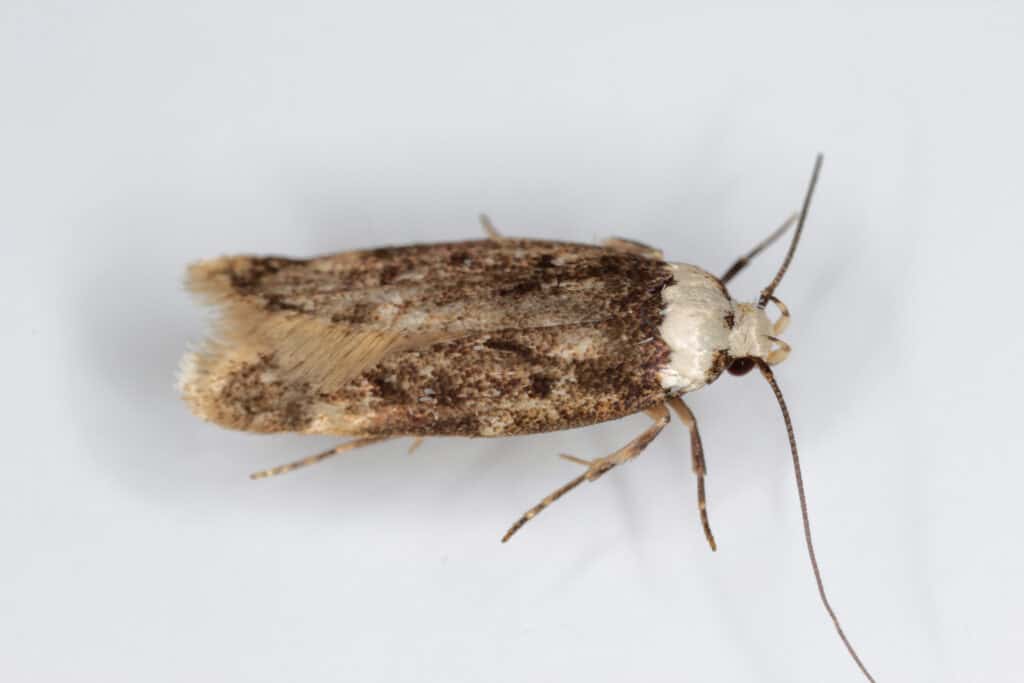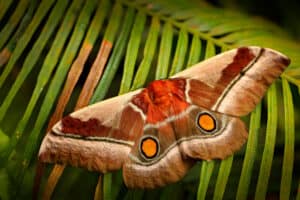As darkness descends, the invisible world of the nocturnal house moth awakens. As we sleep, these winged insects emerge from their hidden crevices, where they embark on their quest for sustenance and shelter. After all, their fondness for darkness acts as a great advantage because they have a better chance of remaining unnoticed. In this blog post, A-Z Animals will reveal what attracts moths and why there are so many moths in your home.
Reasons Why Moths are Attracted to Your Home
The abundant presence of moths in your home is a result of the favorable environmental conditions they are attracted to. These conditions make your home a suitable habitat for moths, increasing their inclination to inhabit such spaces. Inadequate ventilation, moisture retention, and the availability of nearby water sources contribute to the growth of the moth population.
Another factor that may contribute to the presence of moth infestations in your home is the availability of suitable nourishment sources. Moths are notorious for their attraction to various materials, especially natural fibers like wool, silk, and cotton. Carpets on the floors and curtains on the windows can serve as a rich food source for moths, enabling them to reproduce and rapidly increase their populations. It is worth noting that moths prefer to consume stored pantry items like grains and cereals, which adds to their appeal and further entices them to create infestations.
Furthermore, the presence of moths can be influenced by the outdoor conditions surrounding the residence. During certain periods, particularly spring and summer, moths undergo reproductive processes and actively seek sheltered locations to lay their eggs. Proximity to gardens or forested areas, where moths often breed, greatly enhances the probability of their infiltration into your home.
Are Moths Dangerous?

There are a variety of moth species, and although irritating to humans, they have a significant role in the ecosystem.
©Tomasz Klejdysz/Shutterstock.com
There are over 160,000 moth species throughout the world. Moths do not pose any direct health risks or major threats to humans. However, they can be an inconvenience and source of irritation to humans. In fact, moth species are harmless and play significant roles in ecosystems as crucial pollinators and valuable food sources for other animals.
Types of Moths That Commonly Found in Your Home

The Indianmeal moth, or pantry moth, typically infests inside stored food, such as grain.
©Tomasz Klejdysz/Shutterstock.com
Clothes moths
These pests belong to the Tineidae family and are well-known for their destructive effects on natural fibers such as wool, silk, fur, and feathers. The webbing moth and casemaking moth are two common species of clothes moths that can cause significant damage. These moths frequently infest areas such as closets, wardrobes, and storage spaces where natural fibers are present.
Indianmeal moths
Pantry moths, commonly called Indianmeal moths, are frequently encountered in kitchens and pantries. They tend to infest stored food items like grains, cereal, dried fruits, nuts, and pet food. The crawling larvae of these pests, often seen inside food packages, indicate contamination.
Mediterranean flour moths
Like Indianmeal moths, Mediterranean flour moths reproduce in stored food products. These pesky critters frequently hide in flour, cereal, dried fruits, nuts, chocolate, and birdseed.
Brown house moths
The brown house moth, commonly found in households throughout North America and Europe, is a widespread moth species. It can infest various dry food items, including grains, cereal, pasta, and pet food. In addition, the larvae of brown house moths construct silken tubes as their dwelling places.
Grain moths
Grain moths, such as the Angoumois grain moth and the Indianmeal moths, are particularly attracted to infiltrating stored grains, including rice, wheat, corn, and cereals.
Why Are There Moths in Your Home?

Cedar chips and lavender essential oil are good moth repellents if there are moths in your home.
©Madeleine Steinbach/Shutterstock.com
A notable abundance of moths in your home can indicate different scenarios. One possibility is that their eggs have recently hatched, leading to an increased population of adult moths.
Moths display a variety of reproductive patterns when it comes to breeding seasons. Some species actively breed during specific seasons, while others can produce multiple generations throughout the year. The time it takes for moth eggs to hatch can vary depending on factors such as species and environmental conditions. Generally, this transformation from eggs to larvae can take a few days to a couple of weeks.
Tips to Get Rid of a Moth Infestation
Follow the helpful tips below to remove moths from your home.
- Spring clean and sanitize closets, drawers, and pantries, as these dark spaces conceal hidden moth eggs. Furthermore, don’t forget to diligently vacuum your carpets and upholstery to eradicate any potential presence of moth eggs, larvae, or adult moths.
- If your garments are riddled with eggs and larvae, you can either discard or clean them thoroughly by using hot water and soap.
- Moth traps are useful for capturing and preventing moths from reproducing. These traps release pheromones to attract moths while their sticky substance traps them in place.
- Make use of natural repellents such as cedar chips, lavender essential oil, and dried rosemary, as these strong scents repel moths.
- If your moth infestation persists despite your efforts, seek help from professional pest control services.
The photo featured at the top of this post is © Tomasz Klejdysz/Shutterstock.com
Thank you for reading! Have some feedback for us? Contact the AZ Animals editorial team.







